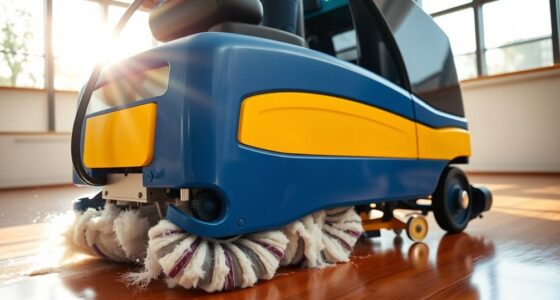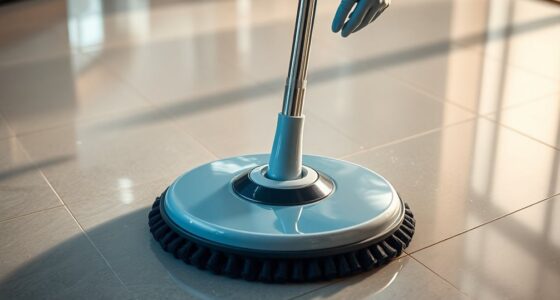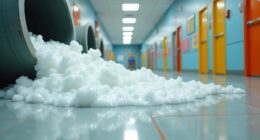Pre-sweeping before polishing concrete is a vital step to guarantee a smooth, flawless finish. You should remove all loose dirt, dust, and debris to prevent contamination and surface imperfections. Skipping this step can lead to scratches, dull spots, and uneven results, making re-polishing more costly and time-consuming. Proper pre-sweeping sets a solid foundation for a professional-looking polished surface. Keep going to discover the key reasons why pre-sweeping is essential for top-quality results.
Key Takeaways
- Pre-sweeping removes loose debris, preventing surface imperfections and embedded debris during polishing.
- It enhances equipment efficiency and surface quality by ensuring a clean, smooth foundation.
- Proper pre-sweeping controls dust and debris, creating a safer, cleaner work environment.
- Skipping pre-sweeping increases the risk of scratches, dull spots, and uneven finishes, leading to costly corrections.
- Overall, pre-sweeping is essential for achieving a high-gloss, durable, and professional polished concrete surface.

Deciding whether to pre-sweep or not on polished concrete can considerably impact the quality of your finish. When you’re preparing a surface for polishing, proper surface prep is essential to achieve a smooth, flawless look. One of the most critical steps in surface prep is dust control, and pre-sweeping plays a crucial role in managing dust and debris. If you skip this step, you risk contaminating the surface, which can lead to imperfections, uneven polishing, and a subpar final appearance.
Pre-sweeping ensures that loose dirt, dust, and debris are removed before you begin grinding or polishing. Without this initial cleaning, these particles can become embedded in the surface during the polishing process, creating scratches or dull spots. Dust control starts with a thorough sweep, often using industrial vacuums or brooms designed to trap fine particles. This step reduces airborne dust, making the environment safer and cleaner, especially in enclosed spaces. It also minimizes the amount of debris that could interfere with equipment and prolong the polishing process.
When you do a proper pre-sweep, you’re effectively preparing the surface for the subsequent steps. Clean, dust-free surfaces allow grinding and polishing tools to work more efficiently, reducing unnecessary wear on equipment and decreasing the risk of surface defects. It also helps you achieve a more uniform finish because the polishing compounds can better adhere to a clean, smooth surface. Skipping pre-sweep might seem like a time-saver, but it often leads to more work later, including re-polishing or addressing surface imperfections caused by embedded debris.
Another reason to prioritize pre-sweeping is to improve dust control during the entire surface prep process. Fine dust particles can become airborne and settle on nearby surfaces, creating a mess and potential health hazards for workers. Using a vacuum during pre-sweep minimizes this airborne dust, maintaining a safer work environment and reducing cleanup time after the project is complete.
In essence, pre-sweeping isn’t just about cleanliness; it’s a fundamental step in surface prep that directly influences the quality of your polished concrete. It ensures better dust control, fosters a smoother surface, and helps you reach that high-gloss, even finish you’re aiming for. Skipping it might seem tempting, but it compromises the integrity of your work and can lead to costly corrections down the line. Proper surface prep, starting with pre-sweeping, sets the foundation for a professional, durable, and visually appealing polished concrete surface. Additionally, understanding dust control techniques can significantly enhance the overall quality and safety of your project.
Frequently Asked Questions
How Often Should I Pre-Sweep My Polished Concrete Floor?
You should pre-sweep your polished concrete floor daily if you notice dust accumulation or debris buildup. Regular sweeping helps remove loose dirt, preventing scratches and maintaining its shine. If your space has high foot traffic or dust sources, consider pre-sweeping more often. Keeping debris removal consistent guarantees your floor stays clean and well-maintained, extending its lifespan and preserving its polished appearance.
Can Pre-Sweeping Damage the Polished Surface?
Pre-sweeping won’t damage your polished concrete if you use proper sweeping techniques. Avoid harsh, aggressive motions that can scratch the surface. Instead, use a soft-bristled broom to gently gather concrete dust and debris. Be mindful of the pressure you apply, as excessive force can create tiny scratches over time. Regular, careful sweeping helps maintain the shine without harming the surface or spreading dust around.
What Cleaning Tools Are Best for Pre-Sweeping?
You should use dust mops or microfiber cloths for pre-sweeping polished concrete. Dust mops effectively pick up loose dirt and debris without scratching the surface, while microfiber cloths are great for trapping fine dust particles. Avoid using harsh brushes or stiff brooms, as they can scratch or damage the polish. Regularly cleaning with these tools helps maintain the concrete’s shine and prevents scratches caused by abrasive tools.
Is Pre-Sweeping Necessary Before Every Polish?
Yes, pre-sweeping is necessary before every polish to guarantee proper dust control and surface preparation. It removes loose debris and dust that can interfere with the polishing process, leading to a smoother, more even finish. Skipping this step may result in a compromised look and durability. Consistent pre-sweeping helps maintain the quality of your polished concrete, making sure the surface is properly prepared for ideal results.
How Do I Remove Stubborn Debris After Pre-Sweeping?
When stubborn debris clings to your polished concrete, don’t fret. You can tackle dust accumulation with a slightly damp mop or a gentle scrub brush to loosen debris, making debris clearance easier. For tougher spots, use a vacuum with a brush attachment to lift stubborn dust and debris without scratching your surface. This approach guarantees your floor stays pristine and ready for the final polish, enhancing its shine and longevity.
Conclusion
Ultimately, whether you pre-sweep or not, your goal is a flawless finish. Think of it as clearing the path for perfection, removing debris as the foundation for shine, dust as the obstacle to clarity, and dirt as the barrier to brilliance. By choosing to pre-sweep, you set the stage for a smooth, reflective surface. Neglect it, and you risk imperfections. Either way, your attention to detail determines whether the concrete gleams or glares.









